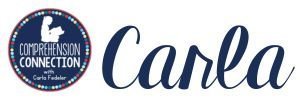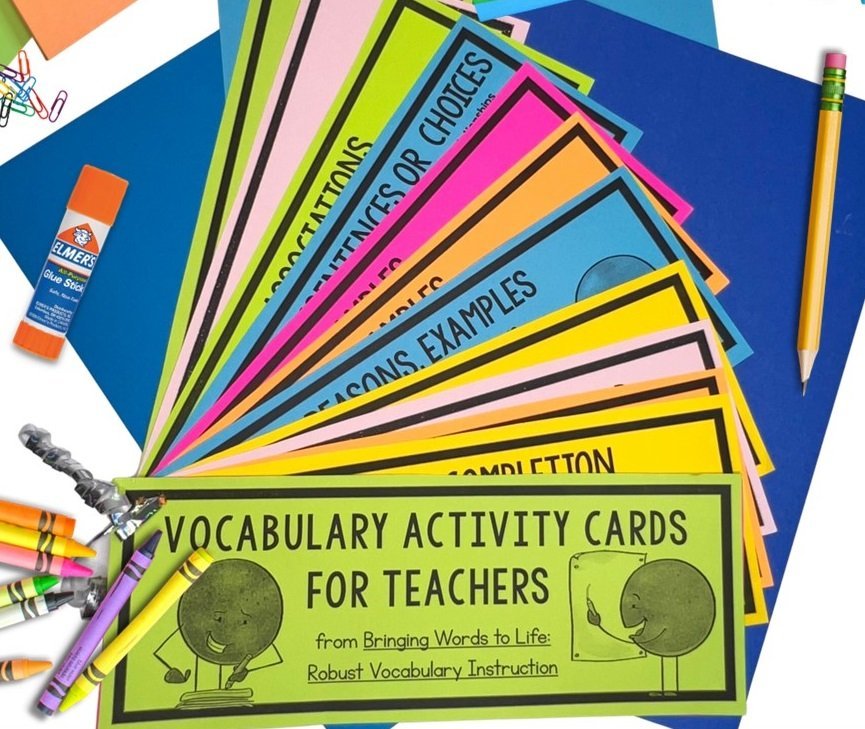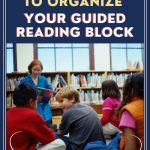
Guided reading can be very helpful for student watching, but organizing guided reading groups can be a time consuming task. Pulling book sets at the appropriate level for your students, determining skills you plan to work on, assessing students to make sure they’re in the right group. It can be really overwhelming when your teaching life is busy. So what can be done to lift the load? How can we get the most out of the 20 minute guided reading lessons?
GUIDED READING SCHEDULES
1) Check your daily schedule
The first thing to look at is your schedule. [THIS POST] includes information on how to map out a reading/writing workshop schedule and the various options teachers might include. Another option is a Daily Five format. Regardless of which schedule format you choose, starting your ELA block with a mini lesson that demonstrates a skill you plan to work on in your guided reading groups is a great idea. This helps things flow from whole group to small group to independent work.
2) Determine student needs and levels.
The schedule within the guided reading block can vary with the reading level of the group you’re seeing. Below, you’ll find a breakdown.
- In kindergarten, all groups should have an opportunity to work in small groups. You’ll focus on word building, sightwords, concept of word, reading patterned books, and writing.
- For the primary grades, the focus shifts to fluency. Teachers should include word building, oral reading (tracking, fluency, accuracy), and comprehension.
- In the middle grades, you’ll typically have a range of levels. Some students will still need help building fluency(level J/K or DRA 16-24). Others will be at the instructional level and need comprehension and writing.
- By fourth and fifth grade, comprehension is essential for growth. (Level N+/DRA 30+). You may see lags in spelling and writing with your striving readers. Use word study and as much writing as possible to fill the gaps through literacy stations and response to reading.
3) Prioritize Your Time
Once you’ve determined your students’ needs and groupings, you need to decide how often to meet with your groups. Your students at the greatest need should meet with you daily while your highest achieving students may need to meet just three days of the week.
PLANNING FOR GUIDED READING
Develop a guided reading Planning Routine
Planning for guided reading really can be time consuming, but it doesn’t have to be. To make it easier, the first step is to develop a planning routine. Decide one day per week that you will pull the books you wish to use for small group. One important thing to keep in mind is to keep a balance between fiction and nonfiction. You may alternate weeks or divide your quarter into teaching blocks for consistency with the standards you are working on. Of course, you also need to track your students’ levels to make the best match.
Build Your guided Reading Binder for Grab and Go Materials
Once you’ve pulled the books you plan to use, the next step is to pull the materials you’ll use in conjunction with your books. But how do you streamline this process? You could spend hours combing Pinterest and TPT for materials to use each week. However, the best solution is to build a guided reading binder with dividers for each reading skill you teach as you find them. Keeping a variety of ways to practice reading skills on hand makes it so much easier to vary your instruction. Agree?
Organize Digital Resources
Another way that I’ve made it easier for myself is to create folders on my desktop by skill/standard too. These work well when I want to project an activity on the Smartboard. As I see/create new activities, I print a copy for my binder and save it to the folder. The key with guided reading is that students get practice reading and working with text at their reading level and with skillwork whether it’s word building, fluency, or comprehension. I look at guided reading as the “We Do” part of the teaching sequence that follows a gradual release philosophy.

Plan for and Use Your Assessments
Another key component to planning for guided reading is assessment. Assessment should include informal observation and anecdotal records (You might keep notes on large address labels that you can adhere to your student’s reading folder), running records with both cold and warm reads. and assessment of skills. Why? Because all of these types of assessments help us in planning appropriate next steps in order to best target what our kids need most at that point. Plus, monitoring your students progress helps you show your students’ growth both to parents and administrators too.
Below is a guide for how often running records should be taken. It is just a soft guide and what I have normally done. Of course, you do what your admins tell you as a minimum.
Reader:
Beginning Readers (Level C-G)
Transitional Readers (Level H-M)
Instructional Readers (Level N and up)
Frequency:
Every 4 weeks
Assess every 4-6 weeks
Every 6-8 weeks
Keep Your guided reading Groups Fluid
Even though running records may seem time consuming, you do not need to drop everything to administer one on one every time you give them. You can and should work them into your guided reading routine using the text that you’re using for your group. Just be sure that you use a COLD read to get an accurate measure of whether the text is at your student’s reading level. Just listen and track accuracy. Make note of fluency behaviors.
Benchmark running records should be done at the beginning, middle, and end of the year, and for these, there are several options. I prefer Fountas and Pinnell’s or DRA. My district began using DRA last year, and we administer just beginning and end of the year. For information on how to administer a running record, check out this post by Judy Araujo. It has great information on types of miscues, how to use the information, and what to expect in terms of performance.
MANAGING your guided reading groups
One of the most challenging tasks related to guided reading is management. What do the other students do while you’re meeting with small groups? This is a common dilemma and the reason some teachers opt to teach whole group and abandon small group instruction. Please have faith and work to teach your students what you expect of them. I’m not saying that you can’t teach whole group. What I’m saying is that you should use whole group instruction to direct small group instruction and what the other students are doing.
Small group instruction is necessary for optimal growth, but we can’t tackle small groups without a plan for the others. If you do, then your classroom will suddenly become party town. Below are a few articles on this important topic:
- The Power of Small Group Instruction
- Differentiation and Acceleration through Small Group Reading Instruction
Now, what do the other students do while you’re meeting with your groups? Well, there are several options that I’ll share, but the most important thing is to teach your students one routine at a time. With a class meeting, you can model, discuss, and post your expectations for each option you choose.
DAILY FIVE
Several years ago, the Daily Five was introduced and many teachers find it easy to follow and explain. It includes five components: Read to Self, Read to Partner, Word Work, Writing, and Listen to Reading. Students choose from this menu while the teacher meets with groups. The system works well for grades K-5 and could be slightly modified for middle school. To learn more about Daily Five, you can visit the sisters’ site [HERE]. Better yet, you should purchase their books. I found them quick to read and very helpful.
LITERATURE CIRCLES/BOOK CLUBS
Another great option for your readers is to set up literature circles or book clubs. I would recommend this option for second grade and up, and again, this will take modeling for your students to work in them without disruption. With these small groups, you’ll start with a book set or novel. The group will pair and read together, spend time working as a group on skills based upon the text, and may create a culminating project once the book is completed. Some teachers use novel studies for these, but you can also assign specific roles to your students following reciprocal teaching.

In my store, you can find Book Clubs Made Easy which follows this approach. It works with any text and comes in both PDF and Digital. This post explains more about using book clubs and literature circles. I highly recommend using Literature Circles/Book Clubs with upper elementary and middle school. One option you have when using them is to float from group to group for small group work. When trained, older students can run their own group.
-
Sale Product on saleBook Club Activities and Resources in Digital and PDF for Upper Elementary
$4.99Original price was: $4.99.$3.00Current price is: $3.00.
LITERACY WORKSTATIONS

In your teaching cycles, literacy workstations can be used for independent practice and assessment. Ideally, it’s good to tie your workstations to the standards you’re teaching. You can center your stations around key literacy skills such as word work/vocabulary, fluency, writing, and comprehension. Through each, you can work your standards in.
For each level of reader (beginning, transitional, or instructional), stations will have a different look. In kindergarten, your stations are geared to your level. You might focus on alphabet/sounds, sightwords, concept of word, or writing. In primary grades, fluency is the focus, so your stations might be word work, fluency, listening to reading/comprehension, and writing. Upper elementary might include vocabulary, word study, comprehension and writing.
Literacy stations take a little time to set up. However, if you have a basic framework in place, changing the content can be done without a huge amount of stress or retraining. The resource above offers one idea. They’re set up into baskets that can be moved to the student groups.
guided reading ROTATIONS
One important thing to keep in mind with stations is that you must remove any disruption to the routine. Kids can’t wonder what to do or look at their station as play time. They must produce something, and they must know exactly where to go and what to do. You might use a rotations board to make the assignments.
The editable powerpoint to the right is what I’ve shared with my teachers as an option. It is projected on the smartboard during small group rotations and includes up to four rotations and up to 5 tasks. The teacher can choose the option that fits his/her schedule. Once set up, you could use the same schedule/learning partners as long as your partners get along.
PROJECT BASED LEARNING
Another great option for students at the transitional to instructional level is project based learning. PBL begins with a leading question that the student is interested in answering. Through reading, research, notetaking, writing, and the design and creation of a final project, the student uses reading to learn in a very purposeful way. PBL is highly recommended as a teaching method for reading and writing growth.
READER’S THEATER
If your students are developing fluency, one effective and research based resource you can and should use are reader’s theater scripts. Students work in teams to read and practice their parts and through repeated reading, students gain fluency. But, there’s more. Reader’s theater can also be used to work on comprehension too. I love using partner plays just to increase the amount of reading, and all of my partner plays include before, during, and after reading activities. Click here for the upper elementary bundle.
-
Sale Product on salePartner Plays Bundle for Upper Elementary, Fluency Activities, Close Reading
$46.00Original price was: $46.00.$25.00Current price is: $25.00.
-
Sale Product on salePartner Plays Bundle for Primary, Fluency Activities, Readers Theater Bundle
$43.50Original price was: $43.50.$25.00Current price is: $25.00.
In the primary grades, you can use them too. For the primary grades (1-3), I developed a series with a seasonal flair and on topics kids enjoy. The main character is Sam (my son’s name) and his dog, Max (my first dog’s name). Topics include birthdays, camping, going to the beach, parades, school, and more. You can check out all of the titles in the image to the left. Click here to learn more.
With both bundles, the goal for me was to combine close reading techniques and fluency building. Each script includes prereading, during, and after reading activities and work well as a literacy station or for small groups. I typically introduce them in our guided reading groups and then move them to stations for the remainder of the week.
FINAL THOUGHTS on guided reading:
Certainly, there are many ways to work your guided reading block, but the most important take away I’d like for you to get is that small group instruction matters. You will always win by meeting your students where they are and by stretching them without frustration. We all get kids with gaps. It’s important for us to be the detective and determine where the gaps are and fill them. When there are no gaps, then it’s up to us to extend and push to the next level.

For more on this topic, there are other blog posts I’d like to recommend you check out. Here they are by title:
- LITERACY WORKSTATIONS AT WORK
- HOW MAKING BOOKS IN THE CLASSROOM HELPS LEARNING STICK
- MAKING READER’S WORKSHOP WORK FOR YOU
- FIVE WAYS TO GET THE MOST OUT OF YOUR GUIDED READING BLOCK
- MAKING THE MOMENTS COUNT: HOW TO SCHEDULE YOUR ELA BLOCK
We’re in the optimal time of year for reading growth, and it’s so important to make those minutes count. Please share your thoughts and more importantly, share what works for you. I believe in the power of collaborative learning, and the philosophy of many hands make work light.
























